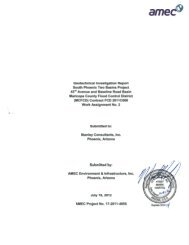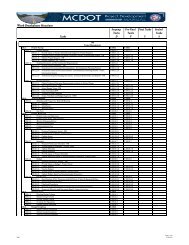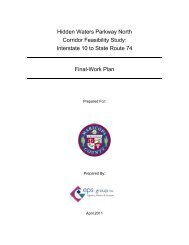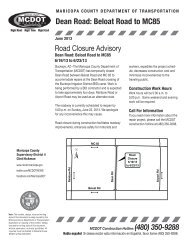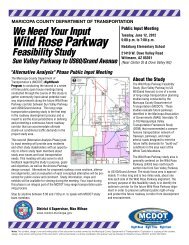Tech Memo #7 - Maricopa County Department of Transportation
Tech Memo #7 - Maricopa County Department of Transportation
Tech Memo #7 - Maricopa County Department of Transportation
You also want an ePaper? Increase the reach of your titles
YUMPU automatically turns print PDFs into web optimized ePapers that Google loves.
<strong>Tech</strong>nical <strong>Memo</strong>randum <strong>#7</strong>Traffic AnalysisPeoria Avenue Corridor Improvement StudyJackrabbit Trail Parkway to Dysart Road3.0 FUTURE TRAFFIC CONDITIONSFuture <strong>Transportation</strong> NetworkFor the planned future network, functional classification is the process by which roads aregrouped into classes or systems according to the kind <strong>of</strong> service they will provide in the future.Roadways functionally classified as high-speed, high-capacity facilities tend to maximizemobility and minimize direct land access. The hierarchy <strong>of</strong> functional classification typicallyincludes freeways, expressways, parkways, major and minor arterials, collectors, and localstreets.<strong>Maricopa</strong> <strong>County</strong> and MAG similarly classify Peoria Avenue as an (urban) principal arterial inthe future network. However, Peoria Avenue actually falls within multiple jurisdictions in thestudy area. Each jurisdiction has assigned its own future functional classification to the portion<strong>of</strong> Peoria Avenue within its boundaries. The overlapping classifications are even more complexwhere Peoria Avenue forms the boundary between jurisdictions.For the planned future network, Peoria Avenue has been classified by the local jurisdictions aslisted below: MCDOT – Urban Principal Arterial MAG – Major Arterial City <strong>of</strong> El Mirage – Minor Arterial City <strong>of</strong> Glendale – Major Arterial City <strong>of</strong> Surprise – Major ArterialThe future MCDOT functional classification <strong>of</strong> Peoria Avenue in the study area is an urbanprincipal arterial, as stated in the <strong>Maricopa</strong> <strong>County</strong> Major Streets and Routes Plan, adopted in2001 and revised in 2004 (Figure 6). The corridor currently exists from Dysart to PerryvilleRoads, and is classified as “future” from Perryville Road to Jackrabbit Trail. A principal arterialis defined as a street that provides for long-distance traffic movement within <strong>Maricopa</strong> <strong>County</strong> orbetween <strong>Maricopa</strong> <strong>County</strong> and urban areas. Access to abutting land is restricted and controlledthrough frontage roads and raised medians, as well as by the spacing and location <strong>of</strong> drivewaysand intersections. Opposing traffic flows may be separated by a raised median.MCDOT also classifies all other one-mile grid roadways in the study area as principal arterials,except Perryville Road south <strong>of</strong> Cactus Road, which is defined as a minor arterial and SR 303L,defined as a future freeway.The MAG I-10/Hassayampa Valley <strong>Transportation</strong> Framework Study identifies Peoria Avenueas a major arterial, as illustrated in the functional classification network map in Figure 7. This issupported in the 2010 MAG Regional <strong>Transportation</strong> Plan (RTP), which defines Peoria Avenueas a four-lane arterial from Dysart to Reems Road, and as a six-lane arterial from Reems Roadto Jackrabbit Trail in 2030 (Figure 8).The City <strong>of</strong> Surprise incorporated area within the study area extends north from Peoria Avenue,between the Beardsley Canal and Dysart Road. Surprise classifies Peoria Avenue as a majorarterial in the current General Plan, illustrated in Figure 9.Page 11 January 2011







